Sorry in advance for the long post, but I thought I'd contribute my own recent experience regarding this: a few weeks back, while winching our 2020 Raptor in reverse through a much-larger-than-expected area of deep clay mud along a gulf coast beach (driving though what appeared to be a mud "puddle" in extremely dense fog was clearly not a wise decision, haha – even when the fog lifted, we could not even see the end of the saturated, more than knee-deep mud, which was more than enough to bottom us out and suction the truck's skid plates to the ground). Well, it turned out that, among the submerged debris in the mud flat, there was the rusting remnants of an old box spring, which snagged on our LH parking brake cable, pulled it out of the EPB housing, and snapped it, which caused it to rapidly recoil around the rear axle, taking out the cables connecting the EPB motor and the LH rear wheel speed sensor, along with the hydraulic flex hose for the disc brake on the same wheel in the process.
The dashboard immediately lit up with probably around 3/4 of all the possible warning lights you can have, giving the appearance of a complete catastrophic failure, haha! As it turns out, in (at least the newer) Raptors, and probably to a similar extent in most modern cars, the wheel speed sensor data is utilized, through the ABS module, by the majority of systems in the car, and they will basically all go into self-protection mode, sometimes beyond what you'd imagine to be necessary, in response. More than two dozen DTCs were thrown, with the vast majority of the Raptor's many modules throwing at least one or two errors. A couple of those errors were due to ≈80% of the brake fluid from pouring out of the completely severed brake hose, and was easily resolved enough to get us home with a couple of vice grips along with some hose clamps and plugs, secured in place with a network of cable ties, and we had enough brake fluid on hand to completely refill the system once the leak was stopped, so we at least had three fully-functioning brakes, which is more than enough on the short drive over flat terrain, especially with a bit of engine braking to assist. A few more errors were due to the disconnected LH parking brake motor, as well as another error due to the parking brake cable tension being "out of adjustment" (I suppose a parking brake cable that exists and functioning vs one that has been ripped off and is now has part of the cable wrapped almost a dozen times around the axle, and with the other half hopelessly tangled in the box spring would qualify as asymetrical tensioning, ahaha.
However, the remaining items from the laundry list of illuminated MILs and numerous active DTCs were all related to the wheel speed sensor being disconnected, and thus sending the ABS module (missing or invalid data). As I've come to understand, one of the things the truck's computers monitor is the plausibility of the data recieved from various sensors, as a sort of self-check to see if the information can be trusted – and when three wheels are going whatever speed they might be, while a forth is reporting either null, zero, or non-numeric data, the truck determines that it cannot know for certain what the vehicle is doing, and cannot be certain that the fourth wheel is on the ground, jammed, missing, encountering more or less resistance than the other wheels, etc., and in response, disabled most dynamic systems and enters a sort of fail-safe mode. It's not full limp mode, like you might get from engine/transmission sensor issues, among other things, and you can still apply any amount of throttle and go any speed (though only using the "Normal" terrain mode profile, as terrain management is disabled whenever any ABS error occurs, or the ABS module is taking offline), but you lose nearly every system that sets the Raptor apart, including:
- Terrain management / off-road modes – it will simply say "terrain management not available" on the IPC if you attempt to switch out of normal mode
- E-Locker – This protection certainly makes sense; the rear diff lock will always refuse to engage if the current speed difference between the rear wheels is too great, and without one of the rear wheel speed sensors, the software cannot accurately determine whether or not the preconditions are met. The one oddity here, though, is that there is no error message when it happened (and no notification that the locker disengaged), and there are no e-locker-specific DTCs thrown – in fact, the diff lock lights in the center of the 4WD mode dial still illuminates (and can be toggled on and off at will), which we realized quickly, since ours was on at the time due to the muddy terrain. The only indication to the driver (apart from a difference in how the vehicle handles terrain where the locker would have helped) is that on the IPC, if you go to the off-road information pages that show the vehicle diagram, the lock icon is absent from the rear axle.
- Cruise control & trail control – Pretty much goes without saying; obviously these features need to know the wheel speeds to be able to accurately adjust control the throttle/brake
- Traction control & Advancetrac – not knowing what one of the wheels is doing certainly hampers the computer's ability to calculate uneven traction or unintended vehicle rotation / sliding
- Hill start assist – The system needs to know if the wheels are stopped in order to activate, and as vehicle manufacturers tend to do, it errs on the side of caution, figuring that unexpected brake actuation at the wrong time is worse that having to handle your own hill starts (plus, in our case, one of the brakes was also out of comission at first, which would definitely hamper this function, haha).
- Incline & steering angle measurements – The inclinometers lost any ability to detect the incline, forward or lateral, and the steering wheel angle reading was always pinned at 0º. I'm not sure why this would be related to a rear wheel speed sensor (especially the steering, which only involved the front wheels), but I think it might just be an unintended consequence from the other modules ignoring all data passing through the ABS sensor, seemingly operating under the assumption that if one piece of data is bad, none of it can be trusted.
- Reverse camera guides – I was a bit surprised when I noticed this, until I saw that the steering wheel angle measurement wasn't updating, either, which would certainly make it very hard to display guides based on the current steering angle, haha.
- Crosswind stabilization – I suppose this might be considered to be simply part of Advancetrac, but I wanted to highlight this one separately, since it was eye-opening to see just how much the truck is still doing even when you've supposedly disabled traction control and Advancetrac – without the sophisticated logic that allows the truck to provide subtle, automatic compensation during events of sudden wind gusts or strong crosswinds, it handles a lot more like you might expect a big, tall off-road truck to handle at higher speeds. It reminded me a lot of driving our old 1997 Silverado on the highway (but with more power, better soundproofing, and without the giant deadzone in the steering, haha – suddenly normal physics seemed to apply, ahaha). You also lose the Raptor's feature where the ABS system subtlely helps keep the vehicle straight when braking hard on surfaces that are loose or other have unequal traction between each tire. This loss of the Raptor's normally surprisingly good road stability and handling at highway speeds was further worsened by the next item, the loss of dynamic suspension.
- Dynamic suspension – The Raptor's suspension using an array of sensor data, including the wheel speeds, as inputs into the selected terrain mode's profile (which is also stuck on normal mode) to determine how to adjust the shocks as you drive. With one of the wheel's speed data missing, it seems that the truck's failsafe plan is to make the suspension always equally firm across all four corners, and while I am not certain of this (especially because I think I've driven in Normal Mode exactly once outside of this incident, and am not particularly familiar with the suspension feel of that mode), it seems that the locked firmness is on the firm end of the spectrum used in that terrain mode. This resulted in the approximate ride quality of a base model rental pickup, and had a noticable negative impact on the handling, especially on rough roads, and over dips, bumps, and potholes.
- Speed-sensitive wipers – Pretty minor, but the truck doesn't seem to consider the speed displayed on the speedometer for adjusting wiper speed with vehicle speed, and instead just disabled completely. Not sure why, since there's no safety hazard with misjudging speed in this case, but they clearly went with the side of maximum caution (shy of disabling the vehicle completely) with all of their decisions.
- Dynamic power steering – contrary to what's been reported earlier in this thread, it doesn't entirely disable power steering when communication with the wheel speed sensor(s) is/are lost, but rather it no longer adjusts the power steering gain with the vehicle's speed, and defaults to the firmest setting (basically the amount of resistance you'd experience driving the truck 100+ mph, which is still enough to make it difficult to accidentially turn the wheels too much at high speed, but is extremely underpowered for turning the truck's rather large tires when stopped or travelling at low speeds using a steering wheel diameter and steering ratio clearly designed for fairly high levels of power steering assistance; I had quite a bit of time to experiment with this, since some of the parts required to fully repair the damage were backordered nationally and took quite a bit of time to arrive (I was at least able to fix the brake right away, since, while I couldn't get my hands on the correct brake hose for a couple weeks, I was able to (just barely) fit the brake hose for a regular F-150 with an electronic parking brake, so long as I fully removed the parking brake motor (not a big deal, since it wasn't doing anything, anyway, as the parking brake cable was also backordered) and temporarily relocated one of the hose brackets, so while I lost most of the nice features of the Raptor until I could get a new wheel speed sensor, I at least had the proper amount of fully functioning, leak-free brakes, which held up to the entire range of suspension travel without issue) – anyway, you can still change the steering feel modes, and if you're stationary and try our sport, normal, and comfort, it's clear that the wheel does become easier to turn as you move toward comfort mode, but all modes are extremely difficult to turn, and even comfort has a similar resistance to my Suburban (which doesn't have quite as large/wide tires compared to the Raptor) when it actually did lose power steering completely, so it's easy to conclude that the system is entirely disabled – it is, however, drivable, and the resistance really isn't a big deal once you're above about ≈20-25mph, and the rotation of the wheels makes up for most of the lost power steering gain (why the failsafe couldn't include logic that treats 0mph, maybe even "parking lot speeds", coming from all the other wheel speed sensors as sufficient confirmation that the vehicle actually is moving slowly (the speedometer still functioned without any noticable loss of accuracy, so I know the logic to calculate speed while ignoring outlier sensor data is implemented in the vehicle's software), is beyond me. The chances that you're not actually stationary, but flying down the road doing an inverse tripod, with three wheels off the ground is effectively zero, haha (and the suspension height sensor data should be able to confirm that, anyway, since if the other shocks are all similarly compressed, the other wheels very obviously aren't all in the air – and even if they were, if the brakes are not applied, there's almost no chance that the other wheels would remain stationary, and would either already have been moving, or would start to turn in the wind — that was a bit lengthy, but the point is, I cannot see any reason why the software couldn't have been written to allow for the normal amount of of power steering gain at low/no speed, which can be safely confirmed via other methods when one wheel speed sensor is offline). Plus, even if you were driving on one wheel somehow, relatively wheel speed with regard to steering shouldn't matter anyway, since in our case (and almost every case like this, since the front wheel speed sensors are much more protected), you'd be on just one rear wheel, so steering wasn't an option, anyway, and there won't be any binding issues, either, if only one wheel is experiencing friction from the ground, ahaha.
- ABS – Finally, the ABS system itself clocks out. And when we briefly drove the car with only three functioning brakes, this probably resulted in a couple terrified pedestrians nearby whenever I'd come to a stop. Despite the stops being normal and quite gradual and smooth, as the weight shifts forward and the backend lifts a bit under braking, the wheel without a functioning brake basically becomes in inverse of an airplane's wheels upon landing: it is still spinning quickly, and doesn't experience the resistance from the brake pads like the other wheels, so without as much weight on it, the tire will chirp and even squeal as though you had locked up the brakes in a panic stop, despite the fact that in reality, I was gradually slowing even earlier than I would normally do with four brakes working. I felt pretty obnoxious and a bit embarassed when returning home squealing a tire at each stop sign in our neighborhood, haha. Oh, and if you do need to brake hard, you'll find that the Raptor's brakes can easily lock up in the dry, and, in the rain, you actually need to pay attention, as I found that the wheels could often lock up with the pedal depressed only about 1/4 to 1/3 of the way down.
I'm sure I'm forgetting some of the others. I think even the speed-related volume compensation was disabled, but I'm not 100% sure, since it's usually pretty subtle, anyway. The majority of computer-controlled features
The other interesting this is the lack of a helpful error for the driver about what actually went wrong. It gave me something around a dozen worrying errors that made it sound like I'd ripped off half of the stuff mounted in the undercarraige and just caused some very expensive damage to a brand-new truck (this happened with just 4,000 miles on the odometer, haha). The only error that seems to be specific to the loss of communication with the broken wheel speed sensor was a very cryptic error that would display on the infotainment screen (nothing on the IPC display) every time you start moving again after coming to a stop: the error "message" was a textless dialog box that filled about 90% of the display, but consisted of almost entirely empty space, except for a small graphic of an overhead view of a pickup truck with a red exclamation point in a circle overlayed on the roof (I've attached an image for reference; it's not my image, but I couldn't find any picture of it on my phone. Probably never got one since it was only while driving, only displays for a brief moment, and my phone is almost always mounted in a holder).
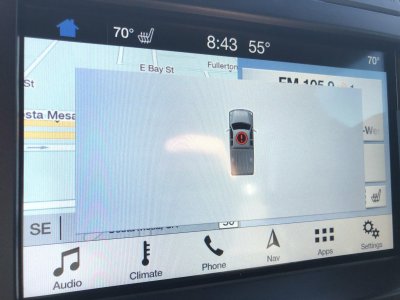
The error on the infotainment screen, apparently relating to the wheel speed sensor, which is definitely not at all helpful to the driver, haha. They could do a little better, it would probably save quite a few folks from ensuing panic that they caused thousands in damage, when it was really just a sensor and/or wire that costs <$50 to replace and takes only a few minutes to swap out. I definitely think it's worth adding a rear wheel speed sensor to the trail repair kit, as it's a quick and relatively painless repair that will get you a ton of lost functionality back. And it's easy to break, too! I've wrapped the replacement's wire in an inner, fairly thick plastic sheathing, plus an outer anti-snag sheathing, which should help with flexible/movable stuff like brush, but wouldn't have saved in our case, which was caught on a tangled mess of metal wire that made up a box spring, submerged in mud so deeply that it was impossible to extract it, not even partially (at least without spending an entire day on digging out a piece of trash, and we'd already spent an entire night extracting the truck, and were not up for more, haha). This is the type of mud that's so heavy it can bend shovels, yet is also a bit like quicksand, and has a surface almost as slippery as ice. Clay certainly is a miserable soil when wet!
Maybe in the future I'll fabricate a shield for this underprotected area of the undercarriage. This certainly seems like a common issue, and it's easy to see why. I also really need to get a winch for the truck soon – we're often out without any other vehicles to pull us, so it's be a huge help and confidence booster.
Now, for your entertainment, here are some pictures of the damage that took out our brake and wheel speed sensor:
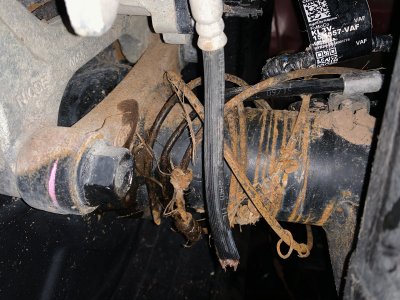
This was the state of the driver's side rear after we got back to solid ground. Ouch. Looks a lot worse than it is, though, and repairing it wouldn't even have taken an afternoon had the parts been available right away. The hardest part was cutting the parking brake cable into sections small enough to extract without scratching or otherwise damaging anything else while unraveling it.
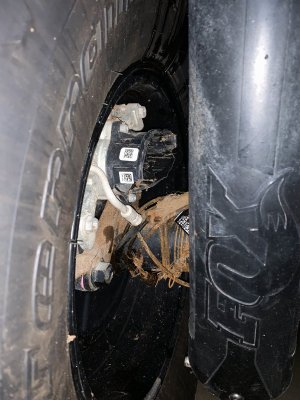
Another view, this time from behind, showing the remnants of the EPB motor.
Now, for fun, here are some shots of what led to all of this:
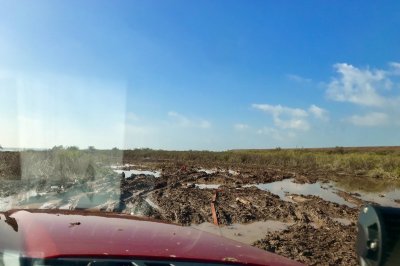
In the morning, the fog cleared, and we were still working on extracting ourselves (we inched along by using the wheel lift attachment on the Hi-Lift jack to pick up the submerged wheels, break some of the suction, and place them on traction boards to inch forward until we bottomed out again, but eventually reached an area too deep and soft to use the Hi-Left (which was also getting jammed from all the clay mud), and had to call for help from someone with a winch. Even then, the suction was so strong that they needed another truck behind them to add anchor weight, and we needed to pool together a couple hundred feet of extra straps so that they could reach us from the nearest solid surface.
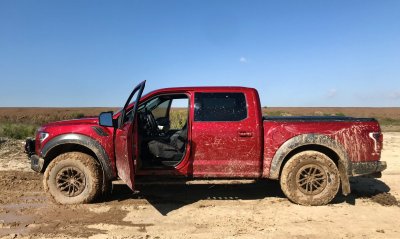
There was so much mud stuck under the truck that, once back on (relatively) solid sand, the truck was riding this low. Based on what fell off at the beach, on the way home, and over the course of a two-day cleanup effort, along with the similarity to how the truck looks when overloaded with cargo, I'm fairly confident that it was well over 500lbs of mud stuck in every little knook, cranny, and frame rail! People were telling me how I needed more lift as the truck rode way too low, haha. That's probably still true for
this level of mud, but I'd never seek out such slop, and learned my lesson about driving though extremely dense fog, trusting that conditions would be similar to a few weeks prior, when the trail was just a few large puddles, but then those puddles never ended this time, haha. Too messy for my taste! (At least I had "emergency" seat covers in the back for situations like this, so I didn't have to get mud into the perforated seats!)






